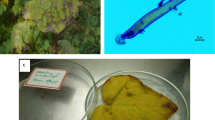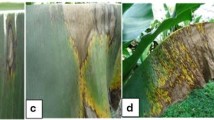Abstract
In August 2014, leaf spots were found on Polygonatum odoratum in Jilin Province in China. The fungus isolated from the diseased leaves was identified as Colletotrichum spaethianum based on pathogenicity, morphology and molecular characterization. The fungus was re-isolated from lesions that developed on leaves after inoculation. This report is the first of a disease on P. odoratum caused by C. spaethianum.


Similar content being viewed by others
References
Carbone I, Kohn LM (1999) A method for designing primer sets for speciation studies in filamentous ascomycetes. Mycologia 91:553–556
Cheon W, Jeon Y (2016) First report of anthracnose caused by Colletotrichum spaethianum on fragrant plantain lily in Korea. Plant Dis 100:1498
Damm U, Woudenberg JHC, Cannon PF, Crous PW (2009) Colletotrichum species with curved conidia from herbaceous hosts. Fungal Divers 39:45–87
Damm U, O’Connell RJ, Groenewald JZ, Crous PW (2014) The Colletotrichum destructivum species complex—hemibiotrophic pathogens of forage and field crops. Stud Mycol 79:49–84
Gardes M, Bruns TD (1993) ITS primers with ITS primers with enhanced specificity for basidiomycetes—application to the identification of mycorrhizae and rusts. Mol Ecol 2:113–118
Glass NL, Donaldson GC (1995) Development of primer sets designed for use with PCR to amplify conserved genes from filamentous ascomycetes. Appl Environ Microbiol 61:1323–1330
Guan Y, Liu Z, Li M, Wang Q, Zhang Y (2018) First report of Colletotrichum spaethianum causing anthracnose in Atractylodes japonica in China. Plant Dis 102:239
Guerber JC, Liu B, Correll JC, Johnston PR (2003) Characterization of diversity in Colletotrichum acutatum sensu lato by sequence analysis of two gene introns, mtDNA and intron RFLPs, and mating compatibility. Mycologia 95:872–895
Guo M, Pan Y, Dai Y, Gao Z (2013) First report of leaf spot caused by Colletotrichum spaethianum on Peucedanum praeruptorum in China. Plant Dis 97:1380
Kumar S, Stecher G, Tamura K (2016) MEGA7: molecular evolutionary genetics analysis version 7.0 for bigger datasets. Mol Biol Evol 33:1870–1874
Liu L, Zhao D, Zheng L, Hsiang T, Wei Y, Fu Y, Huang J (2013) Identification of virulence genes in the crucifer anthracnose fungus Colletotrichum higginsianum by insertional mutagenesis. Microb Pathog 64:6–17
Liu L, Yan Y, Huang J, Hsiang T, Wei Y, Li Y, Gao J, Zheng L (2017) A novel MFS transporter gene ChMfs1 is important for hyphal morphology, conidiation, and pathogenicity in Colletotrichum higginsianum. Front Microbiol 8:1953
O’Connell RJ, Thon MR, Hacquard S, Amyotte SG, Kleemann J, Torres MF, Damm U, Buiate EA, Epstein L, Alkan N, Altmüller J, Alvarado-Balderrama L, Bauser CA, Becker C, Birren BW, Chen Z, Choi J, Crouch JA, Duvick JP, Farman MA, Gan P, Heiman D, Henrissat B, Howard RJ, Kabbage M, Koch C, Kracher B, Kubo Y, Law AD, Lebrun MH, Lee YH, Miyara I, Moore N, Neumann U, Nordström K, Panaccione DG, Panstruga R, Place M, Proctor RH, Prusky D, Rech G, Reinhardt R, Rollins JA, Rounsley S, Schardl CL, Schwartz DC, Shenoy N, Shirasu K, Sikhakolli UR, Stüber K, Sukno SA, Sweigard JA, Takano Y, Takahara H, Trail F, van der Does HC, Voll LM, Will I, Young S, Zeng Q, Zhang J, Zhou S, Dickman MB, Schulze-Lefert P, van Themaat EV, Ma LJ, Vaillancourt LJ (2012) Lifestyle transitions in plant pathogenic Colletotrichum fungi deciphered by genome and transcriptome analyses. Nat Genet 44:1060–1065
O’Donnell K, Cigelnik E (1997) Two divergent intragenomic rDNA ITS2 types within a monophyletic lineage of the fungus Fusarium are nonorthologous. Mol Phylogenet Evol 7:103–116
Santana KFA, Garcia CB, Matos KS, Hanada RE, Silva GF, Sousa NR (2016) First report of anthracnose caused by Colletotrichum spaethianum on Allium fistulosum in Brazil. Plant Dis 100:224–225
Sato T, Muta T, Imamura Y, Nojima H, Moriwaki J, Yaguchi Y (2005) Anthracnose of Japanese radish caused by Colletotrichum dematium. J Gen Plant Pathol 71:380–383
Sato T, Moriwaki J, Kaneko S (2015) Anthracnose fungi with curved conidia, Colletotrichum spp. belonging to ribosomal groups 9–13, and their host ranges in Japan. JARQ 49:351–362
Tomioka K, Moriwaki J, Sato T (2008) Anthracnose of Polygonatum falcatum caused by Colletotrichum dematium. J Gen Plant Pathol 74:402–404
Vieira WAS, Michereff SJ, Oliveira AC, Santos A, Câmara MPS (2014) First report of anthracnose caused by Colletotrichum spaethianum on Hemerocallis flava in Brazil. Plant Dis 98:997
White TJ, Bruns TD, Lee SB, Taylor JW (1990) Amplification and direct sequencing of fungal ribosomal RNA genes for phylogenetics. In: Innis MA, Gelfand DH, Sninsky JJ, White TJ (eds) PCR protocols: a guide to methods and application. Academic Press, San Diego, pp 315–322
Xue L, Li C, Duan T, Nan Z (2018) First report of anthracnose caused by Colletotrichum destructivum on Trifolium repens in China. Plant Dis 102:249
Yang Y, Liu Z, Cai L, Hyde KD, Yu Z, McKenzie EHC (2009) Colletotrichum anthracnose of Amaryllidaceae. Fungal Divers 39:123–146
Yang Y, Lei Z, Cai L, Hyde KD (2012) New species and notes of Colletotrichum on daylilies (Hemerocallis spp.). Trop Plant Pathol 37:165–174
Zhao W, Wang T, Chen Q, Chi Y, Swe TM, Qi R (2016) First report of leaf spot caused by Colletotrichum spaethianum on Lilium lancifolium in China. Plant Dis 100:2328
Acknowledgements
We highly appreciate Prof. Hsiang and Dara Muammad Zulqar Nain for careful review of this manuscript. This study was supported by the National Natural Science Foundation of China (No. 31700010), Phylogeny and taxonomy of Colletotrichum species by using a polyphasic approach on medicinal plants in northeast China. This work was also supported by 111 Project (No. D17014) and the Research Fund (No. 2018YFD0201100).
Author information
Authors and Affiliations
Corresponding author
Ethics declarations
Conflicts of interest
We have no conflict of interest.
Human and animal rights statement
This article does not contain any studies with human participants or animals.
Additional information
Publisher's Note
Springer Nature remains neutral with regard to jurisdictional claims in published maps and institutional affiliations.
Rights and permissions
About this article
Cite this article
Liu, L., Zhang, L., Qiu, P. et al. Leaf spot of Polygonatum odoratum caused by Colletotrichum spaethianum. J Gen Plant Pathol 86, 157–161 (2020). https://doi.org/10.1007/s10327-019-00903-4
Received:
Accepted:
Published:
Issue Date:
DOI: https://doi.org/10.1007/s10327-019-00903-4




